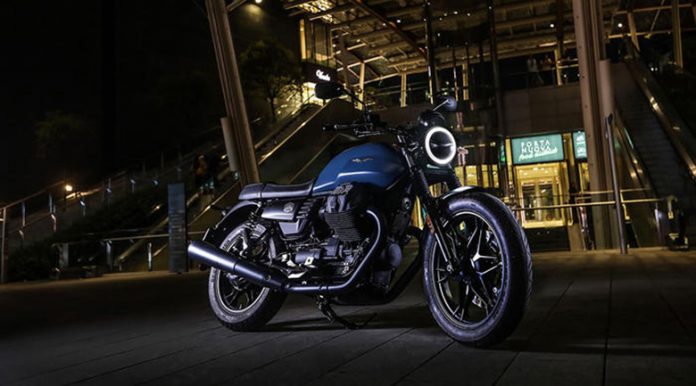The 2020 Moto Guzzi Street Motorcycle V7 III Stone Night Pack is one of Moto Guzzi’s most acclaimed and well-known bikes. This worldwide appreciation stems from its ability to live up to the expectations and reputation of a great brand like Moto Guzzi. Since 1967, when the first line was launched in Italy, the V7 has been a cornerstone of the product line, representing the quintessential Italian motorbike and standing out for its substance and appearance, which has made it very popular with a diverse audience.
V7 III Moto Guzzi is the third act in a unique drama that began more than fifty years ago with an introduction of the first model. Given the fame and success of the Moto Guzzi V7, presenting the Moto Guzzi V7 III was one of the most challenging challenges. Since 2009, it has also been the company’s best-selling model, as well as the entry-level bike in the Moto Guzzi globe.
The Night Pack edition of the eclectic V7 III Stone adds even more punch to an already unusual bike, with innovative aesthetic features and complete LED lighting for a more powerful headlamp, indicators, and taillight.
The Night Pack variant is distinguished by substantial cosmetic and functional alterations, the first of which is the installation of new LED lights, which provide enough illumination power for the headlight, turn indicators, and taillight.
This version, distinguished by the low location of the headlamp and instrument cluster, has a redesigned rear mudguard that is short and elegant and incorporates the brake light bracket and license plate holder.
2020 Moto Guzzi Street Motorcycle V7 III Stone Night Pack – Features and Price
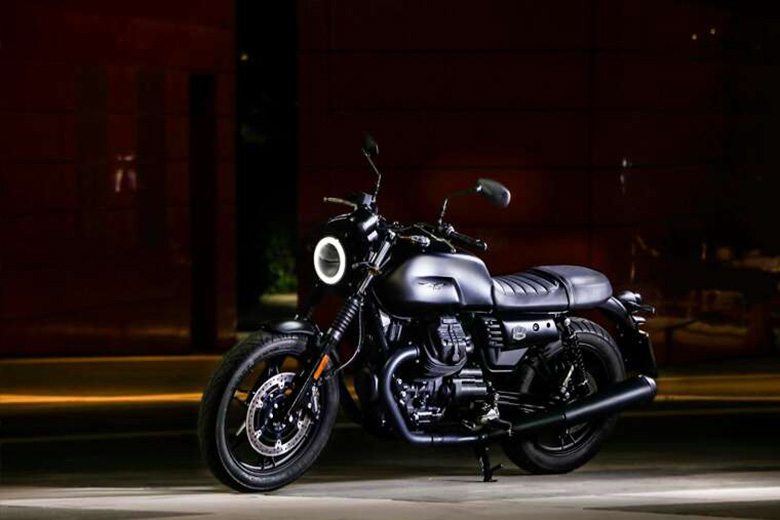
Owning and Riding a V7
The third generation of Mandello’s “seven-fifty” will remain the Moto Guzzi entry-level model. It is easy to ride and one of the most contained in the category in terms of size and weight. It also has a powerful and genuine character, characteristic of all Moto Guzzi motorcycles, and is accentuated by the transversal V-twin engine, a one-of-a-kind design. The key aims driving its development were style, standard equipment, road performance, or characteristics that impact the enjoyment of owning and riding a V7.
The V7 III Moto Guzzi keeps the model’s aesthetic individuality, with a form that communicates with shapes inspired by Moto Guzzi’s legacy and current motorcycle needs. Even though the V7 III is one of the most approachable and elegant bikes, the first impression is that you are in the company of a mature and robust bike, owing principally to the presence of twin-pipe exhaust manifolds and engine heads with substantial proportions. The new metal fuel tank, on the other hand, hasn’t altered, with its superb 21-liter capacity and appearance inspired, as always, by the great 1971 V7 Sport.
All-new injector covers and side fairings, with their streamlined design, also stand out for their elegant elegance. Each V7 III model features a unique saddle with all-new graphics and covers. Keeping with their status as necessary bikes, the V7 III Stone and Rough have a single circular instrument display. Meanwhile, the Special and Racer models include an additional circular display for the rev counter. The speedometer has an analog dial, while the digital box contains all other information: odometer, partial and daily trip, trip time, instantaneous and average consumption, average speed, air temperature, and the MGCT level, as well as the promised gear indicator, for which the user can regulate the minimum and maximum rpm value.
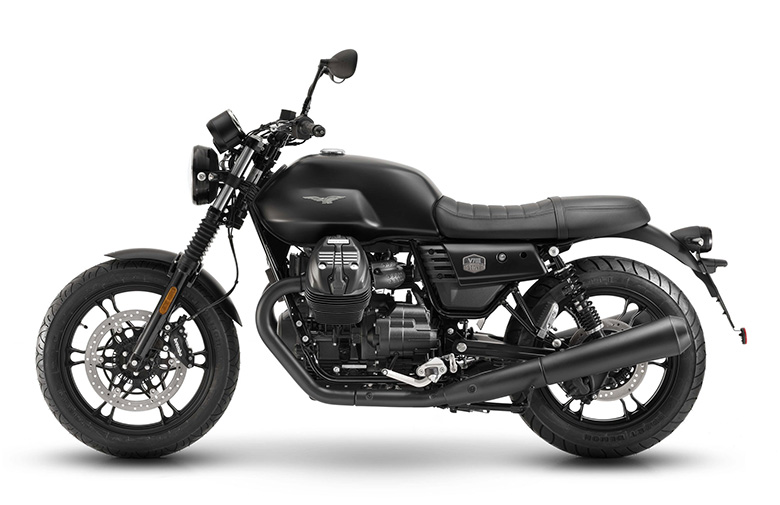
Chassis
Moto Guzzi is well-known for its ability to create unique chassis. The lovely ride of the V7 has its beginnings in the distant past. In 1970, the V7 Police won the selection to join the LAPD (Los Angeles Police Department) squad, establishing the Larian brand’s authority on the subject even abroad. The steel frame continues the double-cradle tubular layout and weight distribution (46 percent front; 54 percent rear) typical of recent V7 tradition; the third generation introduces an entirely revamped and reinforced front end with altered steering geometry to ensure more extraordinary dynamic performance through turns, as well as better handling and stability.
The exquisite care and finish of the details, particularly the welding and painting, have received particular attention. The rear suspension system is based on a pair of Kayaba shock absorbers that are adjustable in spring preload. Because of their exceptional quality and the inclination on the attachment point to the frame, they deliver a progressive and controlled reaction in every condition, even while riding two-up.
Engine
There are plenty of excellent twin cylinder engines in the world, but only one transverse V, and that is the Moto Guzzi twin, born in 1967 thanks to Giulio Cesare Carcano’s creative intuition and distinguished by a unique cylinder configuration that made it an integral part of the motorcycle’s design, like an authentic modern art metallic sculpture. The small-block version has reached its third development. It has been fully redesigned compared to the unit that powered the V7 II to increase riding enjoyment while guaranteeing improved performance and dependability.
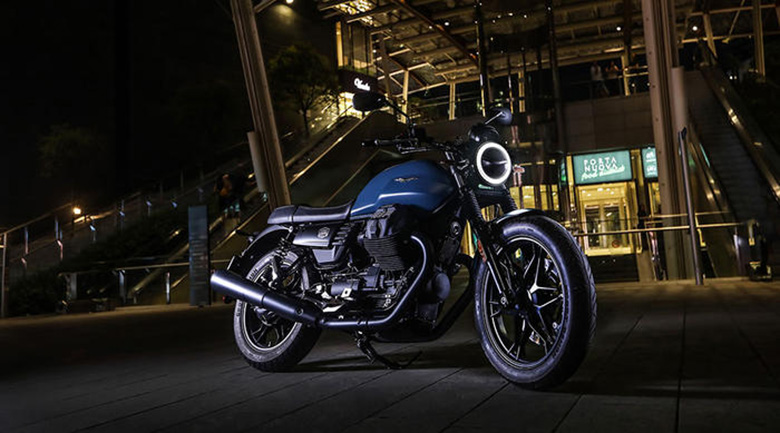
The aluminum crankcase, strengthened at its significant points, employs a crankshaft with calculated inertia to guarantee pep and an appropriate engine brake. The crankcase lubrication system is planned to disperse heat as efficiently as possible while reducing power absorption for improved performance and lower fuel consumption. There is also a ventilation system that decreases power loss due to internal pumping of the crankcase chambers, as well as a reduced capacity oil pump that can absorb less power. The new oil pump intake duct is used, as is the associated by-pass valve and new piston cooling oil jets come standard with flow control and management valve. The blow-by gas output is positioned on the alternator lid.
The changes introduced a year ago also concerned the high part of the engine, with entirely new cylinder heads, pistons, and cylinders in aluminum in comparison to the V7 II, though the new bore and stroke, and thus the engine displacement, remain the same, a choice that sees the V7 III confirm its position as a Moto Guzzi entry-level motorcycle range. Timing is regulated by a pushrod and rockers system with two valves per cylinder but situated in an inclined part (more efficient) in the head, as is customary. The fuel system is governed by an electronic control unit and a single-body Marelli electronic injection system. The exhaust system has twin-pipe manifolds, which aid with thermal insulation. The Moto Guzzi V-twin 750 meets the Euro 4 criteria thanks to the auxiliary air system intake, the trivalent catalytic converter, the double lambda probe, and the engine architecture.
Power is rated at 52 horsepower at 6200 rpm. In contrast, torque is rated at 60 Nm at 4900 rpm, with a flat torque curve promising the comfort of use mixed with the usual character and swift reaction of a Moto Guzzi engine. A reduced-power version is also available, keeping in mind the restrictions imposed by the A2 class driver’s license and suitable for rookie Guzzi riders, who can also depend on a contained overall size and weight, as well as the general ease of riding provided by all V7 III models. Another novel feature of the Moto Guzzi engine is the 170 mm dry single disc clutch, which boosts durability and dependability over time while also reducing the strain on the lever at the new handlebar, all to the benefit of mouldability and riding comfort. The six-speed transmission, which is accurate and smooth in shifting, is identical to the V7 II. Still, it benefits from a new ratio for first and sixth gear, which are both significantly longer, helpful in making use of the engine’s torque and power attributes.
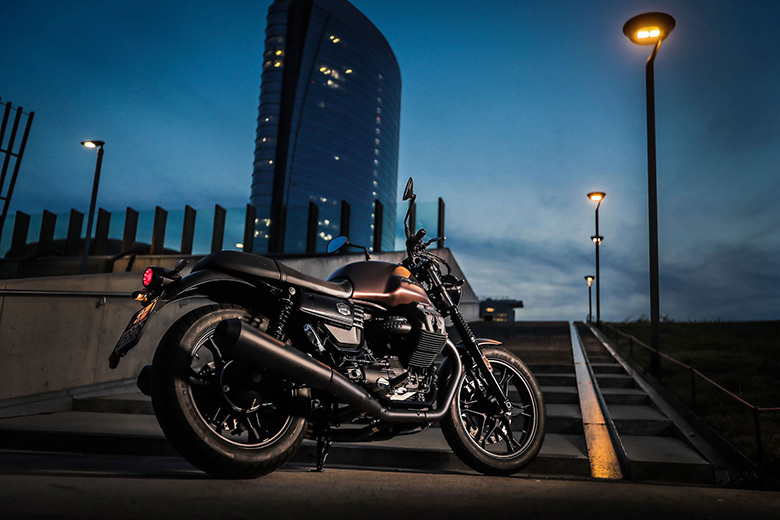
2020 Moto Guzzi Street Motorcycle V7 III Stone Night Pack – Price
All-new 2020 Moto Guzzi Street Motorcycle V7 III Stone Night Pack is available for $8,990 only.
2020 Moto Guzzi Street Motorcycle V7 III Stone Night Pack – Technical Specifications
Engine
| Capacity | 744 cc |
| Bore | 80 mm |
| Travel | 74 mm |
| Distribution | Two valves, including light alloy pushrods & rockers |
| Max Power | 38kW (52hp) @ 6200 rpm |
| Maximum torque @ the crankshaft | 60 Nm at 4900 rpm |
| Exhaust system | 3-way catalytic converter with double lambda probe |
| Cooling | Air |
Chassis
| Frame | Double cradle tubular frame in ALS steel featuring detachable elements. |
| Wheelbase | 1445 mm |
| Trail | 106 mm |
| Headstock angle | 26.4° |
| Front suspension
Travel: |
Ø 40 mm hydraulic telescopic fork
130 mm |
| Rear suspension
Travel: |
die-cast light alloy swingarm having two shock absorbers including adjustable spring preload
93mm (80mm shock absorber stroke) |
| Front brakes | Ø 320mm of stainless steel floating discs, Brembo calipers including four differently sized opposed pistons |
| Rear brakes | Ø 260mm, stainless steel disc, floating caliper having two pistons |
| Front-wheel | 18 inches of lightweight alloy (spoked for Special/Racer/Rough) 100/90 (110/80 R18 alternatively) |
| Rear-wheel | 17″ inches lightweight allow (spoked for Special/Racer/Rough) 130/80 |
Dimensions
| Seat height | 770 mm |
| Length | 2,185 mm |
| Height | 1,100 mm |
| Minimum ground clearance | 150 mm |
| Fuel tank capacity | 21 liters |
| Dry weight | 189 kg |
| Kerb weight | 209 kg |
Others
| Consumption (WMTC cycle) | 5.5 l/100 km |
| CO2 Emissions (WMTC cycle) | 128 g/km |
Conclusion
All-new 2020 Moto Guzzi Street Motorcycle V7 III Stone Night Pack is known for its high-performing engine and stylish chassis. The seat offers a comfortable long ride with an aggressive riding position.

